Related Research Articles
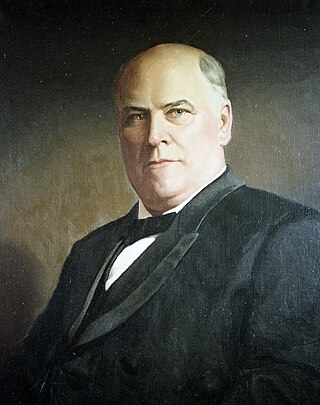
Robert Brodnax Glenn was an American lawyer, prosecuting attorney, U.S. Attorney, and politician who served as a state senator and as the 51st Governor of the U.S. state of North Carolina from 1905 to 1909.

Hanging Rock State Park is a 9,011-acre (3,647 ha) North Carolina state park in Stokes County, North Carolina in the United States. The park is 30 miles (48 km) north of Winston-Salem and is located approximately 2 miles (3.2 km) from Danbury in Stokes County.

Horton Grove was an area of houses for enslaved African-Americans at the 30,000-acre (120 km2) Bennehan-Cameron plantation complex, which included Stagville Plantation in the northeastern part of Durham County, North Carolina. The slaves who lived at Horton Grove were held by the influential Bennehan and Cameron families. In 1860, 900 total slaves were held on the complex. The several structures still standing at Horton Grove are the only two-story slave residences remaining in North Carolina.

Stagville Plantation is located in Durham County, North Carolina. With buildings constructed from the late 18th century to the mid-19th century, Stagville was part of one of the largest plantation complexes in the American South. The entire complex was owned by the Bennehan, Mantack and Cameron families; it comprised roughly 30,000 acres (120 km2) and was home to almost 900 enslaved African Americans in 1860.

Piney Grove at Southall's Plantation is a property listed on the National Register of Historic Places in Holdcroft, Charles City County, Virginia. The scale and character of the collection of domestic architecture at this site recall the vernacular architectural traditions of the eighteenth, nineteenth and twentieth centuries along the James River.
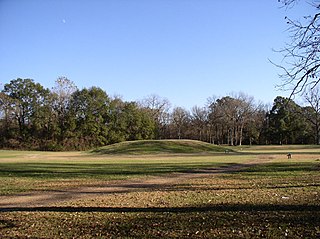
Grand Village of the Natchez, also known as the Fatherland Site, is a 128.1-acre (0.518 km2) site encompassing a prehistoric indigenous village and earthwork mounds in present-day south Natchez, Mississippi. The village complex was constructed starting about 1200 CE by members of the prehistoric Plaquemine culture. They built the three platform mounds in stages. Another phase of significant construction work by these prehistoric people has been dated to the mid-15th century. It was named for the historic Natchez people, who used the site in the 17th and 18th centuries.
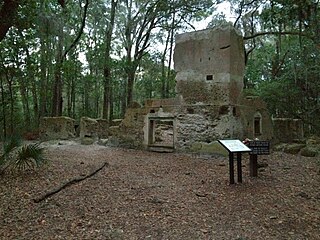
Stoney-Baynard Plantation on Hilton Head Island, SC was listed on the National Register of Historic Places in 1994. The listing included one contributing site on 6 acres (2.4 ha).

The Walnut Hill Historic District is a collection of 40 family dwellings, agricultural outbuildings, and other structures and sites associated with the Walnut Hill Plantation and the Mial-Williamson and Joseph Blake farms near Shotwell, North Carolina. The historic district represents the post-Civil War growth of one of the largest agricultural centers in Wake County. It is situated primarily along the northeast end of Mial Plantation Road between its intersections with Major Slade and Smithfield Roads.
Richmond Hill Plantation Archeological Sites consists of five historic archaeological sites located near Murrells Inlet, Georgetown County, South Carolina. The Richmond Hill Plantation complex sites include remains of the planter's house, two possible overseers' houses, approximately 20 slave houses, a slave cemetery, a rice barn, and rice fields and dikes. The plantation house, overseers' houses, and slave houses were all burned by about 1930. Richmond Hill plantation was owned by Dr. John D. Magill, who was considered one of the least efficient planters in the area and the most brutal slaveowner among the Georgetown District rice planters.
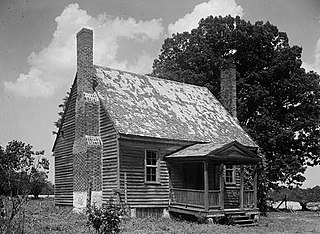
Cascine is a historic plantation complex and national historic district located near Louisburg, Franklin County, North Carolina. The district encompasses 12 contributing buildings, 4 contributing sites, and 3 contributing structures. The main house was built about 1850, and is a large two-story, Greek Revival style frame dwelling, in the manner of Jacob W. Holt, with Gothic Revival style influences. Also on the property is a small, one-story frame dwelling dated to about 1752. It was repaired and refurbished in the mid-20th century. Also on the property are the contributing brick kitchen, frame stable, granary, carriage house, family cemetery, slave cemetery, remains of slave quarters, tenant house, six log and frame tobacco barns, grist mill complex, and archaeological sites.
Massenburg Plantation, also known as Woodleaf Plantation, is a historic plantation house located near Louisburg, Franklin County, North Carolina. The property encompasses 10 contributing buildings, 1 contributing site, and 1 contributing structure. The main house reached its present form in 1838, and is a simple two-story L-shaped dwelling, with a rear two-story wing. It is four bays wide and features a stone block chimney. The property is currently owned by Travis Massenburg. The property also includes the contributing plantation office, smokehouse, cotton gin, storage building, hen house, 1+1⁄2-story Perry House bungalow, and Overseer's House ruins.
Summer Villa and McKay–Salmon House is a historic plantation complex and national historic district located near Lillington, Harnett County, North Carolina. It encompasses seven contributing buildings on a rural farm complex. Summer Villa was built about 1849, and is a two-story, five-bay, Greek Revival style dwelling updated in the early 20th century Classical Revival style. It features a central, two-story pedimented portico supported by monumental Doric order columns with a one-story wraparound porch. The outbuildings associated with Summer Villa include the "Playhouse", carriage house, corn crib and three outbuildings. The McKay–Salmon House built in the last quarter of the 19th century and is a one-story decorated frame cottage.
Sherrod Farm is a historic plantation house located near Hamilton, Martin County, North Carolina. The main part of the L-shaped dwelling is a two-story, five-bay, single-pile, Federal style center-hall plan frame dwelling dated to the first quarter of the 19th century. The one-story pedimented Ionic order portico was added about 1843 and is in a vernacular Greek Revival style. The two-bay one-story Georgian rear ell was raised to two stories in the late-19th century.
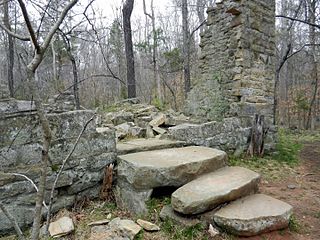
Robinson Rock House Ruin and Plantation Site, also known as Site 31MK272, is a historic archaeological site located in Reedy Creek Park at Charlotte, Mecklenburg County, North Carolina. It is the remnants of an 18th-century stone dwelling of the Colonial period. The Robinson Stone House was probably built between 1780 and 1810. In September, 1979, the site was acquired by the City of Charlotte to be incorporated into a new park and nature preserve.
John Phillips Little House is a historic plantation house located near Little's Mills, Richmond County, North Carolina. It was built between 1850 and 1855, and is a two-story, three-bay, frame dwelling in the Greek Revival style. It features a low hip roof and one-story porch supported by four fluted Doric order columns. Also on the property are the contributing blacksmith's shop, the ruins of the cook's house, the site of the original kitchen, two small dove-tail plank structures, a 20th-century shed structure, and a large plank barn.
Mount Vernon is a historic plantation house, farm complex, and national historic district located near Woodleaf, in Scotch Irish Township, Rowan County, North Carolina. The house was built about 1822, and is a two-story, three-bay, Federal style frame dwelling. It is sheathed in weatherboard and has a full-width, one-story shed roofed porch. The house was designated a post office in 1822. Also on the property are the contributing log smokehouse, large barn, "lighthouse" or Delco house, corn crib, gear house, woodhouse, spring house, mill site, shop, and plantation office.
Dr. David Dickson Sloan Farm is a historic plantation house and complex located near Garland, Sampson County, North Carolina. The house was built about 1849, and is a two-story, five-bay, Greek Revival style frame dwelling. It has a brick pier foundation, low hipped roof, and three-bay pedimented portico supported by Doric order columns. The interior follows a central hall plan. Also on the property are the contributing cook's house, potato cellar, grape arbor, paling fence, garage, and 11 archaeological sites associated with former outbuildings.
Buck Spring Plantation, also known as the Nathaniel Macon House, is a historic plantation house site located near Vaughan, Warren County, North Carolina. The property includes the graves of politician Nathaniel Macon (1757–1837) and his wife Hannah Plummer Mason, log corn crib, smokehouse, caretaker's house, and reconstructed dwelling house dated to the 1930s.
Slatten House, also known as Slatten Thousand Acres, is a historic home located near Bethany, Harrison County, Missouri. It was built in 1856, and is a two-story, five-bay, T-plan, Italianate style frame dwelling. A remodeling project added a belvedere atop the hipped roof during the latter part of the 19th century. The surrounding property includes free flowing springs that feed into cement water troughs, virgin timber and the remnants of virgin prairie, and archaeological remains.

Cornelia Deaderick Glenn was an American society hostess and temperance activist who, as the wife of Robert Broadnax Glenn, served as First Lady of North Carolina from 1905 to 1909. She was involved in the temperance movement and avidly supported her husband's 1908 Prohibition campaign that banned liquor statewide. A devout Presbyterian, she was the founder of one of Winston-Salem's first benevolent societies.
References
- 1 2 3 "National Register Information System". National Register of Historic Places . National Park Service. July 9, 2010.
- ↑ Master Site Record, Research Laboratories of Archaeology, University of North Carolina at Chapel Hill, n.d. Accessed 2014-06-23.
- ↑ Lindley S. Butler and Michael T. Southern (July 1984). "Lower Sauratown Plantation" (PDF). National Register of Historic Places - Nomination and Inventory. North Carolina State Historic Preservation Office. Retrieved February 1, 2015.

